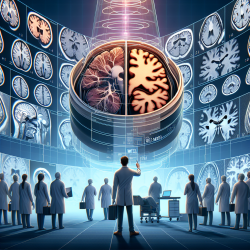The field of neurology is ever-evolving, with new research continually pushing the boundaries of what we know about brain health and disease. One such advancement is the use of quantitative Gradient-Recalled-Echo (qGRE) MRI to visualize and measure tissue damage in cases of inflammatory demyelination. This technique has shown promise in providing practitioners with valuable insights into the progression and treatment of demyelinating diseases.
Understanding qGRE MRI and Its Impact
The study titled "In vivo evolution of biopsy-proven inflammatory demyelination quantified by R2t* mapping" highlights the potential of qGRE MRI as a powerful tool for assessing tissue damage in real-time. Conducted by B. Xiang et al., this research demonstrates how qGRE metrics can serve as biomarkers for tissue damage, offering a non-invasive method to monitor the progression of demyelinating diseases over time.
In this study, a 35-year-old man with an enhancing tumefactive brain lesion underwent a biopsy that revealed inflammatory demyelination. Using qGRE MRI, researchers were able to track changes in the lesion's tissue damage over several months, correlating these findings with clinical improvements in the patient's condition.
Implications for Practitioners
For practitioners working with patients suffering from demyelinating diseases, the implications of this study are significant. Here are some ways you can leverage these findings to enhance your practice:
- Enhanced Diagnostic Accuracy: By incorporating qGRE MRI into your diagnostic toolkit, you can gain a more detailed understanding of tissue damage, aiding in more accurate diagnoses.
- Improved Monitoring: The ability to track changes in tissue damage over time allows for better monitoring of disease progression and treatment efficacy.
- Personalized Treatment Plans: With more precise data on tissue health, you can tailor treatment plans to better meet the individual needs of your patients.
- Encouraging Further Research: Engage with ongoing research efforts to stay at the forefront of advancements in neurological imaging techniques.
The Path Forward
The integration of advanced imaging techniques like qGRE MRI into clinical practice represents a significant step forward in our ability to understand and treat demyelinating diseases. As practitioners, it is essential to remain informed about these developments and consider how they might be applied within your own practice.
By embracing these advancements, you not only enhance your diagnostic capabilities but also contribute to a broader understanding of neurological diseases. This knowledge ultimately leads to improved patient outcomes and a higher standard of care.
To delve deeper into the research findings and explore the full potential of qGRE MRI, I encourage you to read the original research paper: In vivo evolution of biopsy-proven inflammatory demyelination quantified by R2t* mapping.










